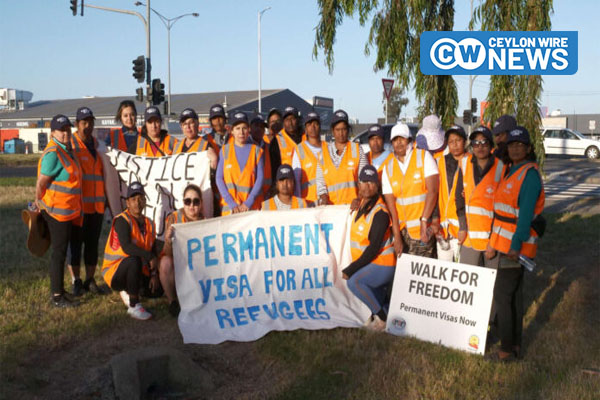Twenty-two women are walking more than 600 kilometres from Melbourne to Canberra to push for permanent protection visas for all asylum seekers living in limbo in Australia.
The women, who hail from Sri Lanka and Iran, arrived in Shepparton in Victoria’s north on Wednesday after setting off on their journey on September 22.
They and their families have all been waiting for permanent visas, instead of bridging visas, for more than 10 years.
Among the walkers is Sri Lankan woman Piumetharshika Kaneshan, who arrived in Australia with her mother and sister when she was just five years old.
(Piumetharshika Kaneshan says the wait for permanent visas has impacted her family.(ABC Shepparton: Callum Marshall)
The teenager said her father and brother were left behind, as the trio left Sri Lanka as quickly as possible for safety reasons.
“I have been here for 12 years and last year my father passed away,” she said.
“I wasn’t even able to see him or touch him for the last time at all.”
Fellow Sri Lankan asylum seeker Harini Rathnakumar also fled her home as a young child.
She lived in India for a number of years and moved to Australia with her father when she was 10 years old.
(Harini Rathnakumar says not having her mother’s support in Australia has been very difficult.(Supplied: Harini Rathnakumar)
She said her father could not afford to pay for her mother, brother and sister to come to Australia as well.
“Not having my mum here is a very difficult part,” she said.
“Being a girl having to grow up with her father and not knowing about anything, say even a woman’s body, is very difficult.
“I wish my mum was here, or even my sister, so they could have led me through that.”
Loss of education options
The group is also pushing for greater work and study rights for all asylum seekers and refugees in Australia.
Many of the women have faced challenges while waiting to achieve permanent residency, including difficulties accessing education.
Iranian Ghazaleh Ghaed-Rahmati said she had been studying health science for a year and a half, until she was told she must stop, after her permanent visa application was rejected.
Mrs Ghaed-Rahmti, who is on a bridging visa, said she was continuing to fight to get permanent residency — a goal that had dragged on for years.
(Ghazaleh Ghaed-Rahmati likens waiting for a permanent visa to living in “limbo”.(ABC Shepparton: Callum Marshall)
“They need to stop this limbo and let people live their life — help them,” she said.
“We came here to be safe and we need that from government.”
Ms Kaneshan said her sister had not been able to study at university due to cost-pressures placed on the family during their wait for permanent visas.
“My sister studied at CIT (Canberra Institute of Technology) because five, six years ago university was incredibly hard for bridging visa people to get in,” she said.
“Even if you get in, you are labelled as an international student and you have to pay what an international student has to pay.
“We weren’t able to afford that because my mum was a single-mum at the time, and she was working eight, nine hours a day with arthritis from head to toe.”
‘Listen to our hope and feelings’
(Rathy Barthlote says she wants the Australian public to listen to asylum seeker’s hopes and feelings.(ABC Shepparton: Callum Marshall)
Sri Lankan woman Rathy Barthlote is helping lead the walk to Canberra.
She has a message for the Australian public and the government.
“Please listen to us,” she said.
“Listen to our hope and our feelings. Please don’t leave us.”
In February, the federal government announced that about 19,000 asylum seekers on temporary protection visas (TPVs) and safe haven enterprise visas could apply for a permanent visa.
Last month, the government lifted Australia’s humanitarian visa intake cap to 20,000 places, from its previous cap of 17,875.
The Department of Human Affairs has been contacted for comment. (abc.net.au)









